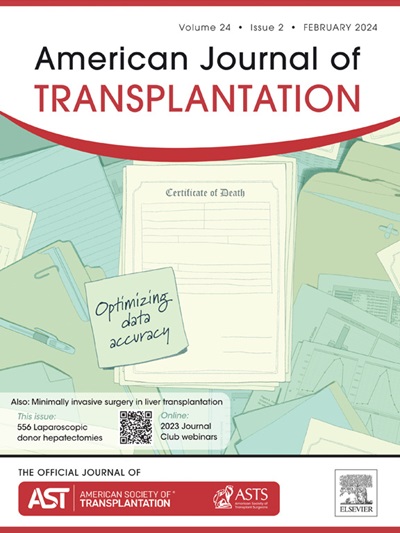Normothermic Regional Perfusion Performed by a US Organ Procurement Organization for Non-thoracic Organ Donors.
IF 8.9
2区 医学
Q1 SURGERY
引用次数: 0
Abstract
Normothermic regional perfusion (NRP) has potential to increase the number and quality of transplanted organs. Most reports showing advantages of NRP have been from transplant centers, but not all centers perform NRP. These advantages could be broadened if organ procurement organizations (OPOs) also performed NRP. We report donation and transplantation outcomes of our first 90 OPO-based NRP non-thoracic donors, divided into 3 eras (n=30 each). Comparisons were made with DCD-direct procurement (DP; n=270) and donation after brain death (DBD; n=729) donors. NRP donor median age was 53 years, compared to DP (48 years, p=0.004) and DBD (44 years, p<0.001) donors. NRP liver utilization (69%, 18 accepting centers) was superior to DP (17%, p<0.001) and not significantly different from DBD utilization (79%, p=0.27) on multivariate analysis. By era, NRP liver utilization progressively increased: 53%, 70%, 83% (p=0.04). NRP kidney use rate (71%) was higher than in DP (60%, p=0.02) and not significantly different from DBD (76%, p=0.15), especially among older donors. NRP kidney DGF incidence (29%) was lower than in DP (47%, p=0.001) and not significantly different from DBD (32%, p=0.53) donors. OPO-based NRP can provide more livers and kidneys to multiple transplant centers and improve outcomes from non-thoracic organ donors.由美国器官采购组织为非胸部器官供体进行的常温区域灌注。
常温区域灌注(NRP)有可能提高移植器官的数量和质量。大多数显示 NRP 优势的报告都来自移植中心,但并非所有中心都实施 NRP。如果器官采购组织(OPO)也实施 NRP,这些优势就会扩大。我们报告了首批 90 名基于 OPO 的 NRP 非胸腔捐献者的捐献和移植结果,这些捐献者分为 3 个时代(每个时代 30 人)。我们将其与DCD-直接采集(DP;n=270)和脑死亡后捐献(DBD;n=729)捐献者进行了比较。NRP捐献者的中位年龄为53岁,而DP(48岁,P=0.004)和DBD(44岁,P<0.001)捐献者的中位年龄为53岁。NRP肝脏利用率(69%,18个接受中心)高于DP(17%,p<0.001),但在多变量分析中与DBD利用率(79%,p=0.27)无显著差异。按年代划分,NRP肝脏利用率逐渐增加:53%, 70%, 83% (p=0.04).NRP肾脏使用率(71%)高于DP(60%,P=0.02),与DBD(76%,P=0.15)无显著差异,尤其是在年龄较大的捐献者中。NRP肾脏DGF发生率(29%)低于DP(47%,P=0.001),与DBD(32%,P=0.53)供体无明显差异。基于 OPO 的 NRP 可以为多个移植中心提供更多的肝脏和肾脏,并改善非胸腔器官捐献者的治疗效果。
本文章由计算机程序翻译,如有差异,请以英文原文为准。
求助全文
约1分钟内获得全文
求助全文
来源期刊
CiteScore
18.70
自引率
4.50%
发文量
346
审稿时长
26 days
期刊介绍:
The American Journal of Transplantation is a leading journal in the field of transplantation. It serves as a forum for debate and reassessment, an agent of change, and a major platform for promoting understanding, improving results, and advancing science. Published monthly, it provides an essential resource for researchers and clinicians worldwide.
The journal publishes original articles, case reports, invited reviews, letters to the editor, critical reviews, news features, consensus documents, and guidelines over 12 issues a year. It covers all major subject areas in transplantation, including thoracic (heart, lung), abdominal (kidney, liver, pancreas, islets), tissue and stem cell transplantation, organ and tissue donation and preservation, tissue injury, repair, inflammation, and aging, histocompatibility, drugs and pharmacology, graft survival, and prevention of graft dysfunction and failure. It also explores ethical and social issues in the field.

 求助内容:
求助内容: 应助结果提醒方式:
应助结果提醒方式:


